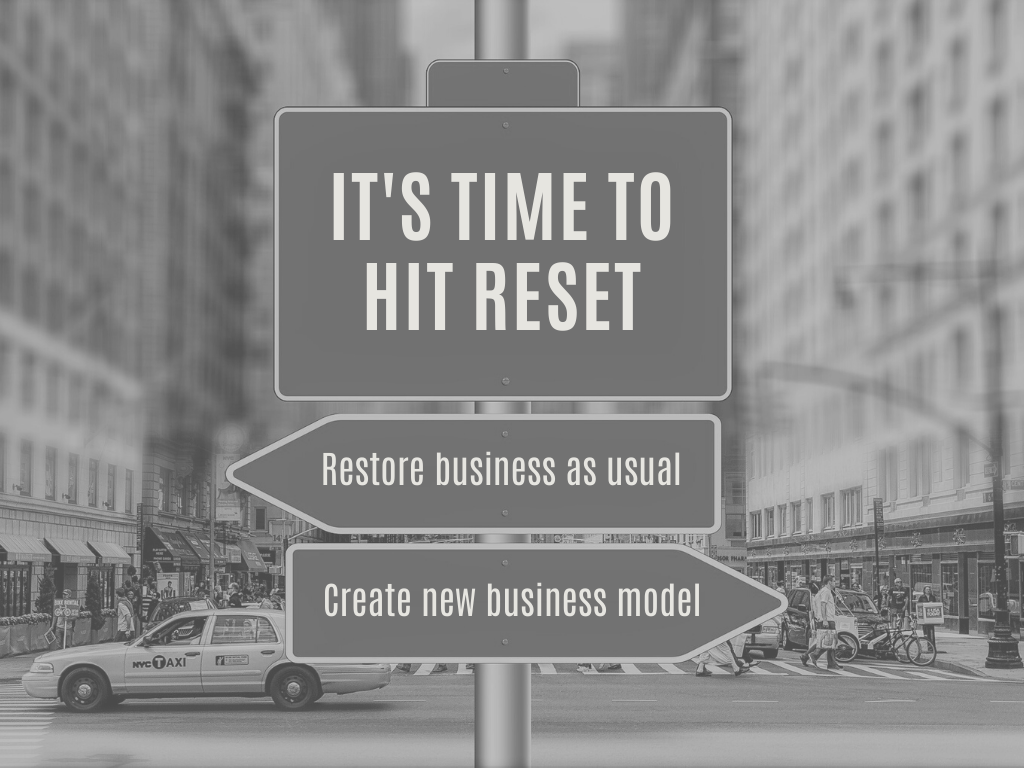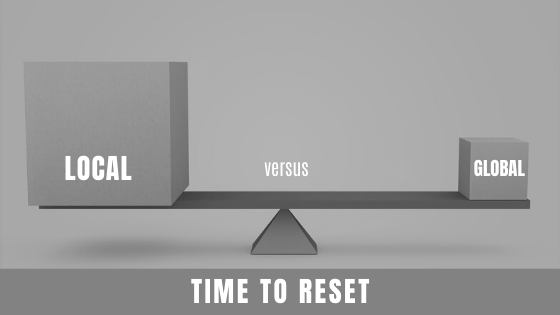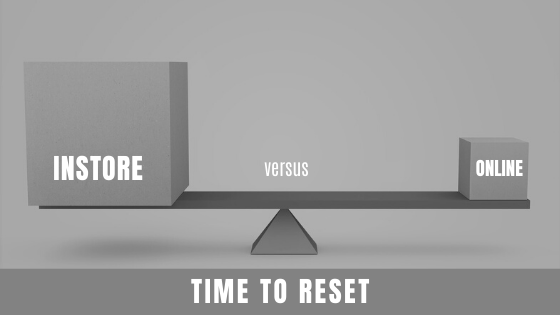Stuck in a holding pattern or working overtime to manage business during the COVID-19 pandemic, the time has now come for us as leaders to hit RESET on our business growth and development strategies as we rethink some of the inherent ways that we do business.
As the new financial year kicks off, the sound of global unrest and uncertainty seems to be hitting our shores with a wave of regularity that is becoming all too familiar.
As the future for most nations still remains unclear, the push for a return to some sense of normality remains critical for our emotional and economic survival.
The world is never going to be the same again, so rather than becoming overwhelmed by the uncertainty that been heightened through fear and insecurity what if we see this as the catalyst to bring about the positive change to our global markets.
Change that will not only get us through COVID-19 but more importantly start to address some of the unspoken systemic problems that have begun to suffocate our global trading sustainability.
Time to reset how we do business
Often, it’s not until something stops or breaks that we hit that fork in the road that forces us to make critical decisions about the future that we would ordinarily avoid.
Without any warning, COVID-19 stopped and broke our economic pathways and led all of us to the cross-road of decision to determine how to navigate the best way forward.
Like it or not, every business regardless of size, location of profitability now needs to choose one of two roads:
OLD ROAD – hold on to previous patterns and behaviours to restore business as usual or
NEW ROAD – maximise the opportunity to create new business operating models

If we are all honest, life prior to COVID-19 within the global market place wasn’t entirely without its issues. As days turned to weeks, years and then decade, business as usual revolved around fast paced, technologically driven business models consumed by size, volume, speed and ultimately bottom line profitability.
In the aftermath of the terrible loss of life that has brought us to this place of contemplation, no one would disagree that as business leaders, we owe it to the generations to follow, to activate positive change that restores a healthy sense of balance to a those areas that have become unstable.
Time to reset the balance between LOCAL and GLOBAL manufacturing and supply

COVID-19 has caused a massive disruption to our global distribution chain across multiple countries, Australia included.
With many of the world’s largest manufacturing factories at a standstill, and the global supply chain in crisis, this unanticipated glitch has shone a flashlight on the reality that no nation is an island unto itself.
Whilst the rewards of globalisation have held many of us in good stead up until now, the sudden and very real closure of international boarders has left entire nations unable to meet local needs and demands through domestic production of many essential items.
In hindsight, it’s very easy to shut down our manufacturing plants and give away our raw materials when our stores were overflowing with value packed consumer products returning healthy bottom line profits.
However, what happens now, when our shelves are running empty and our ports and borders are closed?
As advertisers scramble to promote the ‘buy local’ sentiment, we need to ask ourselves the question: what’s it really going to take to not only change consumer behaviour but more importantly business behaviour when it comes to producing and investing in locally sourced goods and materials, long term?
Neither an easy or quick question to answer, yet a critical one for all of us. One that is going to take a unified commitment and approach from all stakeholders to address long term, however, one that can begin from the ground up as together we hit a reset on the way we market.
As business owners, now is the time to review and evaluate the position that we hold in this critical balance and activate changes to bring sustainability back to our shores.
Time to reset the balance between INSTORE and ONLINE purchases

Prior to COVID-19, the accelerated growth of global online shopping had already set fear into the hearts of many brick and mortar businesses as they watched their consumers turn to digital devices to finalise their purchases.
As shop closures dominated many of our retail’s giants’ chain by chain, it seemed that the pendulum of consumer behaviour had well and truly begun its shift away from the instore experiences, towards online services.
As the rate of online sales increases continued to gain momentum, it seemed that the forecast for our instore colleagues remained quite grim.
March 2020 and the sudden closure of all physical shops with the exception of those selling essential items left shoppers in a world of panic.
For many consumers, it seems that this forced closure of physical outlets for online retailing wasn’t quite the full experience they were looking for and the cry to re-open local shops grew louder and louder.
If the COVID-19 experience has taught us anything about the battle between instore versus online, it has clearly shown us that it’s not a question of one or the other but rather a healthy balance of both.
For business to survive through and post COVID-19 with a sustainable foundation that will withstand other economic disturbances, hitting a reset on how we market means taking a very real and invested look into how as we can profitably, best serve our consumers’ needs through both instore and online experiences.
Time to reset the balance between DISCOUNT marketing and building VALUE

20%, 30%, 50 % and even up to 70% off. We’ve seen it, we’ve used it and more importantly we’ve all purchased goods that have been heavily discounted because, why buy something at the normal retail price when you can get it on SALE.
As intelligent consumers we have all come to terms with an over saturated market place where retailers start with heavily inflated profit margins and then offer exceptional discounts to beat the competition. Whilst the recommended retail price used to reflect a products value positioning within the marketplace (low end, middle, high end), sadly for many, the onslaught of discount activity and special offers across all industries at all ends of the marketplace has eroded the perception of a products true value or worth.
Promotional ON SALE pricing or discounting has become a natural part of life in most well-developed nations and a thriving competitive tool for most retailers. Driven by a host of psychological benefits, brands rely on promotional pricing to gain an edge on their local competition.
However, in the face of growing global and digital competitive activity across most industries, it seems that the frequency and percentage of promotional offers has continued to escalate to the point where one has to ask the question: how is this constant price war impacting the ‘real value’ of our brands, goods and services in both the short and long term and where can it go from here?
Sadly, as prices continue to tumble, the impact that this is having on consumer perception and behaviour is demonstrated in a decrease in consumer trust and confidence, a decline in perceived brand value and a growing precedent for ongoing price reductions.
Just one or two generations ago and the model for promotional activity was at best a 10% price reduction that took place once or twice a year to clear superseded stock. Buying locally made products from well-established and trusted artisan manufacturers was common practice leaving both consumers and producers with a healthy sense of pride, profit and value in their transaction.
With literally a world of products now at our fingertips, business survival and sustainability in this new decade still hangs on the thread of consumer perception and behaviour.
With the much of globe still in some form of isolation, what better time than now to reset the way we market by working together as industry bodies to re-visit the price/value proposition in order to establish more sustaibnable forms of competitive activity.
Are you ready to RESET how you do business?
At creative excellence, we understand the uncertainties that all executives and brand managers are facing at this moment and recognise the need for a calm and well-informed strategic reaction.
The issues mentioned within this insight whilst brief in nature are serious and complex and will require the commitment of all stakeholders to bring about sustainable change.
At creative excellence our passion is to partner with leaders who are equally passionate about creating positive change. If you’d like more information about how we can assist you in helping to strengthen your marketing and business resolve during this season of change, we look forward to hearing from you.
Author’s insights:
As an Integrated Marketing Strategist with over 20 years’ experience in brand marketing, roslyn whately knows what it takes to keep a brand relevant, profitable and sustainable.
